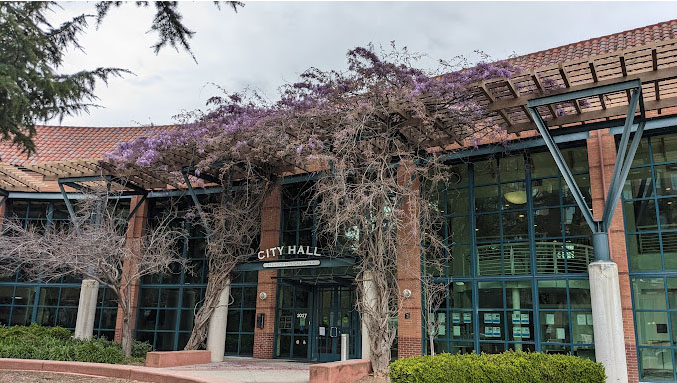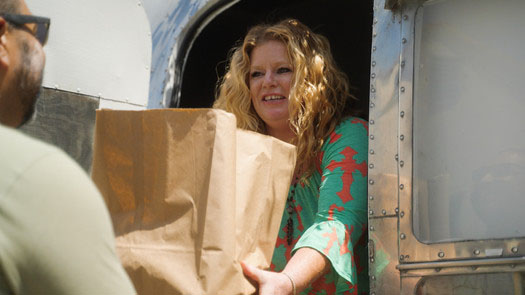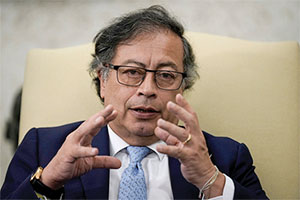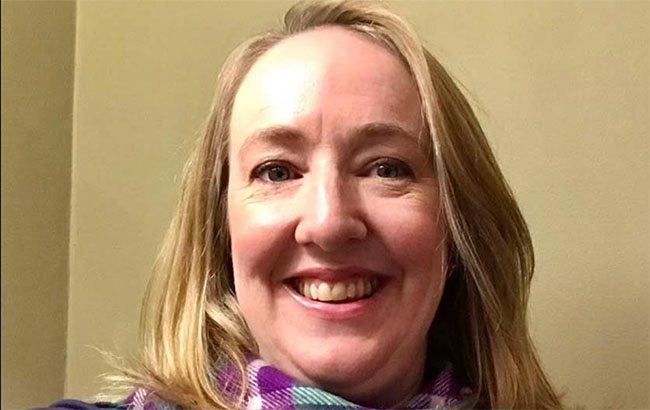Failed legislative bills have attempted to create safe parking programs for students to sleep in their cars on California campuses while awaiting housing. Meanwhile, Long Beach City College allows homeless students to park overnight
September 18, 2024 – Pink hues adorn the horizon as the sun rises on a nondescript parking lot at Long Beach City College. The lot is quiet but not empty, with the same gray asphalt and slightly faded white lines as any other one on campus. But from 10 p.m. to 7 a.m., it is much more than a place to park.
The lot is a designated area for Long Beach City College’s Safe Parking Program, an initiative from the college’s Basic Needs Center that offers safe overnight parking for students and connects them to resources like showers and Wi-Fi. The program was created to address a particular student demographic: homeless students living in their cars.
A report from the Community College League of California found that 2 out of 3 of the state’s community college students struggle to meet their basic needs and almost 3 out of 5 are housing insecure.
To help these students, multiple legislative measures have tried to create safe parking options similar to Long Beach City College’s. The most recent effort was Assembly Bill 1818. Introduced by Assemblymember Corey Jackson early this year, the bill would have required the California Community College and California State University systems to create pilot programs to provide safe overnight parking for students living in their cars.
“Parking lot homeless programs are a best practice that’s been used throughout the nation; churches have done it, cities have done it, it’s time for colleges to step up and do it too,” Jackson said.
The bill was killed in the appropriations committee on Aug. 16, but would have required the California State University to select five campuses to participate in the pilot program; the California Community College chancellor would have had to select 20. The pilot program would have lasted through 2028.
The appropriations committee, which assesses the financial viability of a bill, estimated establishing pilot programs across the Cal State system would cost around $500,000 as well as an additional $2.25 million in annual costs. For the California Community Colleges, the committee estimated between $91,500 and $112,00 in one-time costs and $10 million to $13 million in annual costs for the duration of the program.
Justin Mendez, coordinator of Long Beach City College’s Basic Needs Program, oversees the safe parking program and said those estimates sound high, although he acknowledges that costs will vary from campus to campus. Long Beach City College has been able to fund their program for less than the committee’s estimated costs by working collaboratively with other departments and using existing contracts.
While the bill had garnered support from organizations like the California Faculty Association and the Student Senate for California Community Colleges, several community college districts and the California State University system opposed it. Some of their concerns include liability risk and cost. They also argue that providing secure overnight parking is not a permanent solution.
etitia Clark, chief communications officer for the South Orange County Community College District, said the district has been investing in programs that support basic needs, including housing, as well as exploring building housing on campus as part of their facilities master plan.
“We don’t want any mandates or anything that would take away from that, and especially with an alternative that we actually don’t think is safe and really provides a good quality of life for our students,” Clark said.
Mendez at Long Beach City College acknowledges that overnight parking is not a housing solution.
“We’re not in the understanding that providing our students a safe place to park is providing them housing,” Mendez said, adding that the program is just one of the many resources available for students facing housing insecurity. However, overnight parking provides an immediate safe space while students are connected to longer term housing.
Providing holistic support
Started in 2021, the program has evolved over the years. The lot is now located next to the college’s campus safety building, which has allowed Long Beach City College to cut down on the nearly $500,000 they spent the first two years hiring an outside security company. Students have access to the bathroom in the campus safety building throughout the night and can access the locker room showers from 6 a.m. to 9 a.m. at the nearby school stadium.
Being next to the campus safety building means overnight security officers and parking employees periodically check in on the lot as part of their routine rounds. Mendez said that despite there not being 24/7 surveillance there haven’t been any safety issues.
The lot has 15 parking spots reserved for safe parking participants from 8 p.m. to 7 a.m. although the program can have around 30 folks enrolled at a time. Mendez said they rarely have issues with capacity because students use the resource to varying degrees — some enroll as a backup because they are at risk of losing their housing, others may only need a night or two while they wait to relocate.
Students in the Safe Parking Program need to be enrolled in the primary terms of fall and spring. However, they can continue using the program during summer and winter without being enrolled during those terms. They must also be independent; service animals are allowed but students can’t be living in their vehicle with family or have dependents.
These eligibility requirements have evolved as Mendez and his team assess what is realistic and better serves students. Originally, the program required students to have their vehicles registered and an up-to-date license but now that is something the college assists them with.
Once enrolled in the program, students receive a welcome packet, sign a liability release form and are connected with a case manager to find long-term housing, whether that be through one of the college’s community partners or elsewhere.
For the 2022-23 academic year, the program had a total of 24 students. Twelve of them found transitional or permanent housing. For fall 2023, 21 students enrolled in the program, two obtained permanent housing and 19 of them continued into spring 2024.
The community has also been supportive of the program. Mendez said that since it started, the program receives donations of blankets, gift cards, hygiene kits and other necessities.
Elliot Stern, the president of Saddleback College, spoke against AB 1818 during a Senate committee hearing, arguing that colleges need to get students out of their cars and into their basic needs centers so their needs can be “addressed holistically.”
At Long Beach City College, students access the parking program through the basic needs center and its online request form. What began as a COVID-19 emergency aid application has continued to be a useful one-stop-shop application for students seeking help.
“For all of our basic needs efforts, we always take a wide scope and try to cast the widest net we can,” Mendez said.
The survey asks whether students are facing housing insecurity, which could mean they are struggling to pay rent or have to move frequently, or if they are homelessness, meaning they don’t have a permanent place to live. If they answer yes to either, the survey then asks if they’re sleeping in their vehicle, couch surfing, staying in hotels or borrowing a room.
Through this data, the Basic Needs team can directly connect students with specific resources. For students who self-identify as living in their cars, the outreach coordinator then refers them to the Safe Parking Program.
When students aren’t allowed to park
AB 1818 was inspired by the experiences of students attending campuses without overnight parking. The bill originated as a response to Cal Poly Humboldt evicting students living in their vehicles.
On Oct. 25, 2023, Cal Poly Humboldt students received a mass announcement stating that the university would begin enforcing a parking policy it had previously overlooked and would be evicting students who were found sleeping in their vehicles overnight.
One of those students was Caleb Chen, a second-year public sociology graduate student. He applied to Humboldt in late June of last year and knew finding housing would be difficult. After doing some research, he learned about the university’s alternative living community and figured it would be feasible to live out of his van.
Chen was in the graduate lounge with a friend when they both got the email.
“Oh, the jig is up,” his friend told him.
The eviction announcement said allowing students to sleep in their cars was “unsanitary” and “unsafe” — terminology that not only made students feel dehumanized but also something they considered inaccurate.
Brad Butterfield, president of the Alternative Living Club, a school club created by Humboldt students living in their cars to form a community and advocate for establishing a mail service, said the administration brought up similar sanitation concerns when they pitched the idea of a safe parking program on campus.
“We don’t need, nor ever asked for, bathrooms, showers or security,” said Butterfield, a journalism senior. “All we need is a place to park overnight.”
Butterfield lives in an RV, which has a built-in bathroom. He has a membership at a local gym and showers there. For students without RV’s, Chen said there still are bathrooms on campus that are open 24/7 and that most undergraduate students shower in the school gym.
“It’s really difficult to be pretty much told that you can’t exist,” Butterfield said. “We weren’t causing any harm. We all kept a really low profile.”
Butterfield said that at the time of the evictions, 25 to 30 students were living in their cars. Some lived in discrete vehicles like SUVs while others lived in RVs like him.
The email announcement stated that campus officers had received calls from members of the community “expressing fear and frustration about the situation.”
“There were never any issues between the vehicle dwellers on campus,” Butterfield said. “Not between us as a community and certainly not between us and the campus community at large.”
According to Butterfield, it was quite the contrary. He said some students had told him they felt safer knowing there were students in the parking lot at night who could call the police if anyone was trying to break into their car — something the group had done in the past.
The stigma around homelessness is something that Mendez from Long Beach City College has been fighting since the beginning of the safe parking program. He said the staff have a student-centered approach and are mindful of treating students with dignity.
“There’s all of these negative stereotypes about what a homeless person is instead of realizing that these college students are coming here to be successful. They’re coming here to work on their long-term goals and help themselves and their families,” Mendez said. “I think that level of dignity has made the biggest impact beyond the actual connection of housing partners.”
The mischaracterization of homeless students is what ended a 2019 bill that was also advocating for safe parking. Assembly Bill 302 was introduced by Assemblymember Marc Berman, and would have required community college campuses to allow overnight access to parking, bathroom and shower facilities for students living in their cars.
The bill made it to the appropriations committee where it underwent significant amendments that Berman said “watered down the bill” and “treated homeless community college students like pedophiles” by placing restrictions for campuses within a certain distance from elementary schools.
“It was really unfortunate and damaging in terms of stigmatizing homeless students. And so, because of a lot of those reasons, we decided to stop the bill from moving forward and work on other solutions to the issue,” Berman said. He later drafted Assembly Bill 132, which successfully passed and required every California Community College to establish a basic needs center and hire a basic needs coordinator.
In 2020, another student tried starting a pilot overnight parking program at his campus. Grayson Peters, now a UCLA alumni, was a founder of UCLA Safe Parking and came across similar arguments from his administration at the time.
He said UCLA administrators told him allowing students to live in their cars and park overnight was “fundamentally unsafe.” Peters said that while he agrees with the statement, the alternative can be even more dangerous for students.
“Students are actively sleeping on unsecured city streets a few blocks over, without the benefit of university guards or university facilities or the student gym nearby to go to the restroom in the middle of the night if they need to,” Peters said. “The status quo is more unsafe than the solution we’re proposing.”
Butterfield and his partner have experienced that risk. After being evicted, they tried to find safe places to park around the city. But Arcata has a 72-hour parking limit, which meant they had to relocate every three days. Butterfield said the Arcata police have harassed them multiple times.
“It feels like we’re constantly trying to outrun the police because they keep wanting us to move from here to there to here to there,” Butterfield said.
Cal State Humboldt referred students to a safe parking program run by a local nonprofit organization, but that program ended this summer.
Stephanie Goldman, the associate director of the Student Senate for California Community Colleges, said data shows that a student’s proximity to campus can affect their academic outcomes.
“[Safe parking] is not only giving them a safer option, but an option that is conducive to them reaching their goals,” Goldman said.
Such was the case for Chen in Humboldt, who, before the eviction, was doing much better academically because the commute time was so short and he didn’t have to stress about where he would spend the night.
Chen spent the remainder of the semester and the following one at a local public parking lot. He now lives in a studio apartment he can afford because of loans and scholarships and is splitting rent with his partner who moved up to Humboldt.
“When that announcement happened in November, it was just a wrench into a lot of people’s livelihoods let alone academic success,” Chen said.
Jackson said he was disappointed that the bill was “mischaracterized” by the educational systems as encouraging students to live in their cars as opposed to more effective interventions. Moving forward, now that the legislature is on a break until January, Jackson said he will be scheduling a meeting with the Cal State and California Community Colleges chancellors to see if “there’s ways that we can still get this done.” If not, he will be reintroducing the bill next year.
The Student Senate for the Community Colleges said they will continue to advocate for student basics needs including securing funding for dorms.
Jetaun Stevens, a senior staff attorney with the nonprofit law firm Public Advocates, said she hopes the bill returns with a greater coalition behind it. She said that while AB 1818 was mostly sponsored by the author, working with advocacy organizations who can co-sponsor the bill would help bring forward student stories and amplify the potential impact of the bill.
“Oftentimes it does take [bills] that are somewhat controversial quite a few times before they make it across the finish line,” Stevens said.
Briana Mendez-Padilla is a fellow with the College Journalism Network, a collaboration between CalMatters and student journalists from across California. CalMatters higher education coverage is supported by a grant from the College Futures Foundation.














